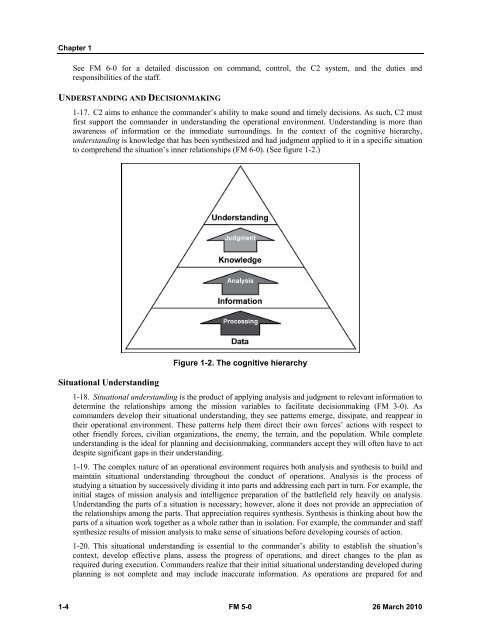FM 5-0, The Operations Process - Federation of American Scientists
FM 5-0, The Operations Process - Federation of American Scientists
FM 5-0, The Operations Process - Federation of American Scientists
Create successful ePaper yourself
Turn your PDF publications into a flip-book with our unique Google optimized e-Paper software.
Chapter 1<br />
See <strong>FM</strong> 6-0 for a detailed discussion on command, control, the C2 system, and the duties and<br />
responsibilities <strong>of</strong> the staff.<br />
UNDERSTANDING AND DECISIONMAKING<br />
1-17. C2 aims to enhance the commander’s ability to make sound and timely decisions. As such, C2 must<br />
first support the commander in understanding the operational environment. Understanding is more than<br />
awareness <strong>of</strong> information or the immediate surroundings. In the context <strong>of</strong> the cognitive hierarchy,<br />
understanding is knowledge that has been synthesized and had judgment applied to it in a specific situation<br />
to comprehend the situation’s inner relationships (<strong>FM</strong> 6-0). (See figure 1-2.)<br />
Situational Understanding<br />
Figure 1-2. <strong>The</strong> cognitive hierarchy<br />
1-18. Situational understanding is the product <strong>of</strong> applying analysis and judgment to relevant information to<br />
determine the relationships among the mission variables to facilitate decisionmaking (<strong>FM</strong> 3-0). As<br />
commanders develop their situational understanding, they see patterns emerge, dissipate, and reappear in<br />
their operational environment. <strong>The</strong>se patterns help them direct their own forces’ actions with respect to<br />
other friendly forces, civilian organizations, the enemy, the terrain, and the population. While complete<br />
understanding is the ideal for planning and decisionmaking, commanders accept they will <strong>of</strong>ten have to act<br />
despite significant gaps in their understanding.<br />
1-19. <strong>The</strong> complex nature <strong>of</strong> an operational environment requires both analysis and synthesis to build and<br />
maintain situational understanding throughout the conduct <strong>of</strong> operations. Analysis is the process <strong>of</strong><br />
studying a situation by successively dividing it into parts and addressing each part in turn. For example, the<br />
initial stages <strong>of</strong> mission analysis and intelligence preparation <strong>of</strong> the battlefield rely heavily on analysis.<br />
Understanding the parts <strong>of</strong> a situation is necessary; however, alone it does not provide an appreciation <strong>of</strong><br />
the relationships among the parts. That appreciation requires synthesis. Synthesis is thinking about how the<br />
parts <strong>of</strong> a situation work together as a whole rather than in isolation. For example, the commander and staff<br />
synthesize results <strong>of</strong> mission analysis to make sense <strong>of</strong> situations before developing courses <strong>of</strong> action.<br />
1-20. This situational understanding is essential to the commander’s ability to establish the situation’s<br />
context, develop effective plans, assess the progress <strong>of</strong> operations, and direct changes to the plan as<br />
required during execution. Commanders realize that their initial situational understanding developed during<br />
planning is not complete and may include inaccurate information. As operations are prepared for and<br />
1-4 <strong>FM</strong> 5-0 26 March 2010















